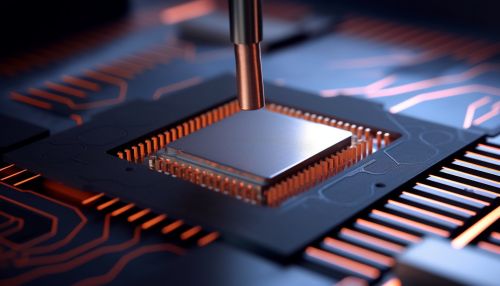Thermal Interface Materials
Overview
Thermal interface materials (TIMs) are substances inserted between two components in a system to enhance thermal coupling. These materials are crucial in thermal management of electronics, as they facilitate the efficient transfer of heat from components such as processors to heat sinks, where the heat can be dissipated into the environment.
Types of Thermal Interface Materials
There are several types of TIMs, each with unique properties that make them suitable for different applications.
Thermal Grease
Thermal grease, also known as thermal paste or heat sink compound, is a type of TIM that is often used in personal computers and laptops. It is a viscous fluid substance which increases the thermal conductivity of a thermal interface by filling microscopic air-gaps present.
Thermal Pads
Thermal pads are pre-formed squares or rectangles of solid material commonly used as thermal interfaces between heat sinks and heat-producing electronic components, such as CPUs and GPUs.
Phase Change Materials
Phase change materials (PCMs) are substances with a high heat of fusion which are capable of storing and releasing large amounts of energy. They are used in TIMs to absorb and transfer heat in response to changes in temperature.
Thermal Adhesives
Thermal adhesives are materials that both adhere components together and provide a thermal path between them. These are often used when mechanical fasteners are not an option.
Performance Factors
Several factors influence the performance of TIMs, including thermal conductivity, thickness, and surface properties.
Thermal Conductivity
Thermal conductivity is a measure of a material's ability to conduct heat. A higher thermal conductivity indicates that the material can transfer heat more efficiently.
Thickness
The thickness of the TIM also affects its performance. Generally, a thinner interface leads to better heat transfer, as there is less material for the heat to pass through.
Surface Properties
The surface properties of the components in contact with the TIM can also affect its performance. For example, a rough surface can increase the contact area between the TIM and the component, improving heat transfer.
Applications
TIMs are used in a variety of applications, primarily in electronics and computing where they aid in heat dissipation from components to heat sinks or other cooling devices.
Electronics
In electronics, TIMs are used to manage heat in devices such as processors, power transistors, and LEDs.
Computing
In computing, TIMs are used in CPUs, GPUs, and other high-performance components to facilitate heat transfer to cooling devices.
Future Developments
Research is ongoing into new types of TIMs with improved properties, such as higher thermal conductivity and thinner interfaces. These could potentially offer improved performance in heat management in electronics and computing.
See Also
Heat Sink Thermal Conductivity Phase Change Material Thermal Management (Electronics)


